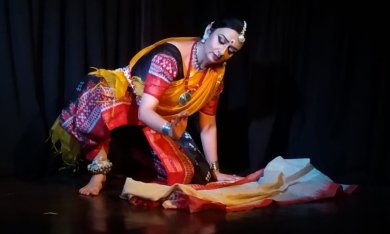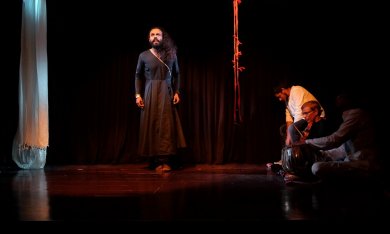
|   |

|   |
 e-mail: ukb7@rediffmail.com Social and metaphysical narratives in Odissi March 7, 2019 Vrityant Human civilisations are replete with events where patriarchy has held sway over a generally submissive matriarchy and the latter had allowed the dominant masculinity to take over control and assumed a nurturing role of providing care and comfort in the society. History has, however, known other occasions when patriarchy had bludgeoned the female species into submission and extracted a most heinous price from the latter. The glaring cases - happening mostly in wars and anarchy -- were the "comfort women" forced into sexual slavery by the Imperial Japanese Army in occupied territories before and during World War II, drawn from occupied countries, including Korea, China, and the Philippines. Similar instances, nearer our time, have been the Khan soldiers in East Pakistan before the liberation of Bangladesh and, more recently, by the IS troops in the Middle East "using" women as sex slaves. In yet a third category, dominant women have played a submissive role to let go of their overflowing ego - wholly justified - and surrendered wilfully to the "chosen ones", fully aware of the consequences. The Mahabharata -- India's own "ocean of stories" -- offers two such episodes: the Manipuri princess Chitrangada opposite Arjuna and the powerful demon queen Hidimba accepting the Aryan, Bhima for her "Prince Charming". In the second story, Hidimba, one of the lesser known and rarely examined characters of the epic, is a moving example of women's struggles, particularly of those who are outside the pale of dominant socio-economic milieu. Even though she appears to willingly make her own choices, Hidimba's only option to negotiate the existing power structures is to accept conditions of diminished fairness and equity, and make personal sacrifices as a wife and a mother. Therein lies the dilemma, ambiguity, complexity and poignancy of the choices women are forced to make. The Mahabharata war plays out not only on the battlefield of Kurukshetra, but also in the minds and bodies of the victors and the anguished, the dead and the alive.  Sreyashi Dey  Dheeman Bhattacharyya Vrityant weaving dance, spoken word, music and movement, was presented on February 9 in Kolkata by the US-based senior Odissi dancer Sreyashi Dey and the theatre actor and scholar Dheeman Bhattacharyya. In the finale Hidimba, Sreyashi depicted the colourful character of the fierce, reclusive outcaste, crafting skilfully her Odissi bhramri, chari and utplavana, and blended them with ufli movements of Seraikella Chhau. Another feature was her verbalising vachika abhinaya that suited the story-telling technique. In order to accord Hidimba the same status as a classical heroine, Sreyashi chose to mingle some sringara songs, which suited well her thesis that Hidimba, as a woman, had the same emotions and desires as any other uttama nayika, even though she was depicted as a rakshasi as per the concept of the traditional epic. Simultaneously, the dancer used a few melodies in folk style not to lose sight of her indigenous origin. The drama in the narrative came out quite well. The overture to the whole program was a traditional Odissi abhinaya item Manini. Through dance and spoken words, Sreyashi and Dheeman explored together, Radha's varied moods of eagerly waiting for Krishna, decorating the kunja and then getting sorely disappointed and dejected when Krishna did not arrive. The crafting of the choreography and the choice of the Odissi music (in Oriya and Sanskrit) were kept at a traditional plane, almost as a counterpoint to the unconventional theme that was going to accost the viewers later - a dancer's highly personal interpretation of a complex social being. There was another interlude Niraba Rajani (the Silent Night), a solo theatre work by Dheeman. As an artistic impression based on Tagore's well-known short story, The Hungry Stones, it explored the inner world of an artist, the process involved in creating the meaning of one's impulses, only to realise the futility of capturing those moments through words, images or gestures. The lyrical journey did give an inter-disciplinary impression, but needed much more cohesion. This piece was accompanied by live music -- with violin, flute, tabla and kahan. Ananta
The cosmic quest of the world and beyond starts from the viewpoint of Pancha Bhuta (five elements), manifest as an coalescence to form the life force and then disintegrates to ensure a celestial traverse at the atomic level. An innovative production in the lyrical Odissi style, Ananta was an exploration of some of the most profound philosophical concepts from the ancient Vedas and Upanishads. Choreographed by Arnab Bandopadhyay in Odissi style, the visualisation also blended creative movements, classical and contemporary music, and Vedic chanting, with the latter rendered soulfully by the noted classical vocalist Dr. Subhadra Desai. Ananta presented on February 14 by Darpani, had the narrative focussing on Creation, with the dancers etching multiple patterns with the chant of the three cardinal verses of Nasadiya Sukta from the Rig Veda - Then even nothingness was not, nor existence / There was no air then nor the heavens beyond it...; there was neither death nor immortality / Nor was there the torch of night and day... and finally, That one who came to be, enclosed in nothing / Arose at last, born of the power of heat... Next came an 'Om' chanting and the classic benediction from Kalidasa's Abhijnana Shakuntalam - Ya shrishtih snashturadhyaa bahatii... The first of the five elements was Earth, partly Nitya (universal) and the rest Anitya (perishable). The hymn to Earth came from the Atharva Veda - Let your hills and snowy mountains, let your forest lands, O Earth, be pleasant; upon the brown, black, fixed earth, guarded by Indra -- I have stood upon the earth: unharassed, unsmitten, unwounded... The next element was Water with two characters - eternal in the shape of atom; and Karya (work) as in river, pond or sea as perishable. The dancers reflected gestures for water and rains, tuned to the verse from the Rig Veda - Yaa aapoh divyaa utvaa sarvanti... The third element was Vayu (air) which again had two levels - Eternal Atom and perishable Karya. The dancers visualised how one felt air as one breathed in and out, how one perceived storm or strong breeze, but air at atomic level remained around us, eternally still. Subhadra sang sonorously the hymn from the Atharva Veda - Apaanati cha pranaanti purusho garbhe antaraa...
Agni (Fire) was the penultimate element, again with eternal and perishable elements. Dancers recreated the Hindu mythology according to which Agni was one of the eight guardians who guarded our Universe. Fire then was invoked -- for its fiery exterior - with a verse from Gritsamada Bhargava - Twam agne dhumih, twam aashu shuddhwati... The final element was Space, Ether or Sound, having only one character - eternal. It was celebrated with a verse from the Chandyogya Upanishad - Which is the ultimate return point of the world? It is the Space. All the beings originate from the Space and finally return unto the Space. The Space is larger than all other beings and Space is their ultimate destiny... Ananta, as a whole, considered that the energy of five elements awakens one's inner channels, with an understanding of one's internal energy, purifying one's negative illusions, and leading to a state of equilibrium. With script by Sreyashi Dey and music by Sandipan Ganguly, Ananta was a dynamic and moving performance of haunting beauty.  Dr. Utpal K Banerjee is a scholar-commentator on performing arts over last four decades. He has authored 23 books on Indian art and culture, and 10 on Tagore studies. He served IGNCA as National Project Director, was a Tagore Research Scholar and is recipient of Padma Shri. Post your comments Please provide your name and email id when you use the Anonymous profile in the blog to post a comment. All appropriate comments posted with name & email id in the blog will also be featured in the site. |